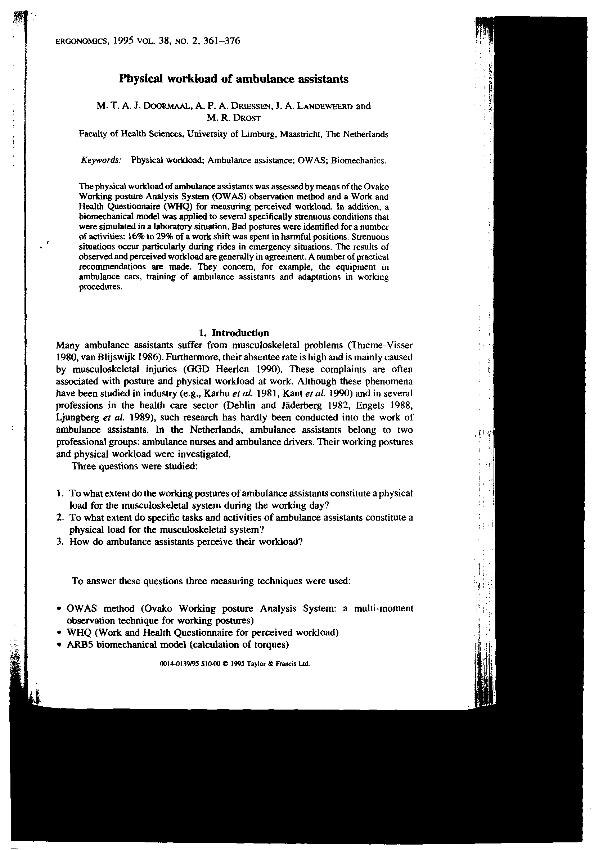Physical workload of ambulance assistants

Contenido multimedia no disponible por derechos de autor o por acceso restringido. Contacte con la institución para más información.
| Tag | 1 | 2 | Value |
|---|---|---|---|
| LDR | 00000nab a2200000 i 4500 | ||
| 001 | MAP20071024460 | ||
| 003 | MAP | ||
| 005 | 20080418121114.0 | ||
| 007 | hzruuu---uuuu | ||
| 008 | 960321e19950201gbr|||| | |00010|eng d | ||
| 040 | $aMAP$bspa | ||
| 084 | $a875 | ||
| 245 | 1 | 0 | $aPhysical workload of ambulance assistants$cM.T.A.J. Doormaal... [et al.] |
| 520 | $aThe physical workload of ambulance assistants was assessed by means of the Ovako Working posture Analysis System (OWAS) observation method and a Work and Health Questionnaire (WHQ) for measuring perceived workload. In addition, a biomechanical model was applied to several specifically strenuous conditions that were simulated in a laboratory situation. Bad postures were identified for a number of activities: 16% to 29% of a work shift was spent in harmful positions. Strenous situations occur particularly during rides in emergency situations. The results of observed and perceived workload are generally in agreement. A number of practical recommendations are made. They concern, for example, the equipment in ambulance cars, training of ambulance assistants and adaptations in working procedures | ||
| 650 | 1 | 1 | $0MAPA20080550653$aErgonomía |
| 650 | 1 | 1 | $0MAPA20080557140$aAmbulancias |
| 650 | 1 | 1 | $0MAPA20080586713$aPersonal sanitario |
| 650 | 1 | 1 | $0MAPA20080570873$aTrabajo físico |
| 650 | 1 | 1 | $0MAPA20080557348$aBiomecánica |
| 650 | 1 | 1 | $0MAPA20080545048$aPostura |
| 650 | 1 | 1 | $0MAPA20080591960$aMétodos de análisis |
| 650 | 1 | 1 | $0MAPA20080565244$aCuestionarios |
| 700 | 1 | $0MAPA20080216795$aDoormaal, M.T.A.J. | |
| 740 | 0 | $aErgonomics | |
| 773 | 0 | $tErgonomics$dLondon and Washington$gVol. 38, nº 2, February 1995 ; p. 361-376 |

